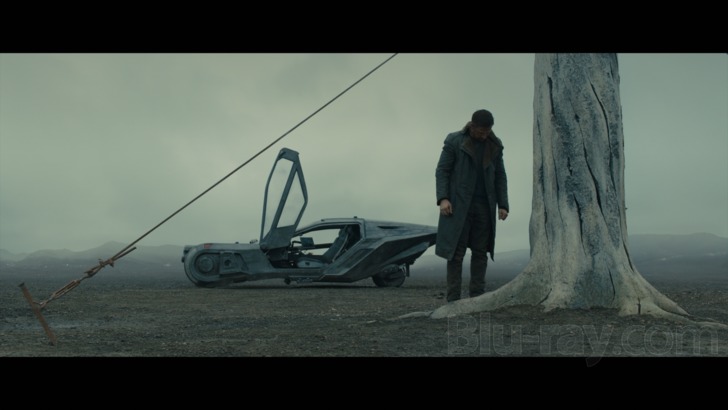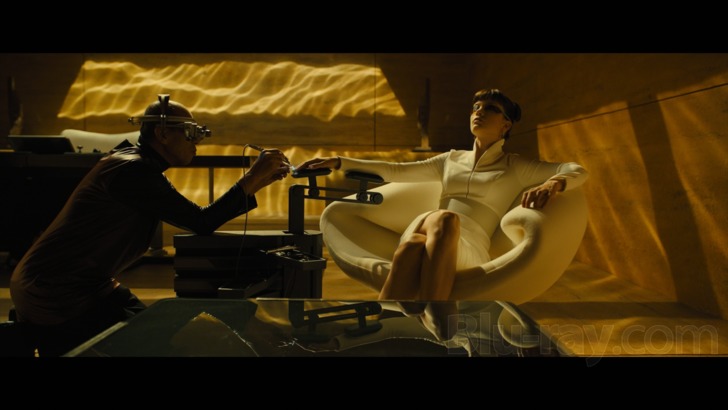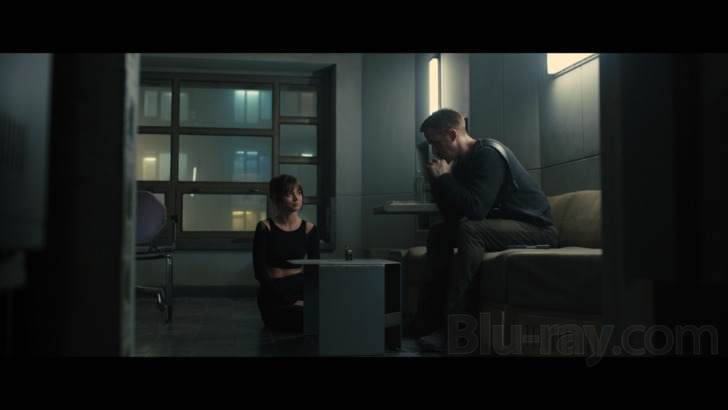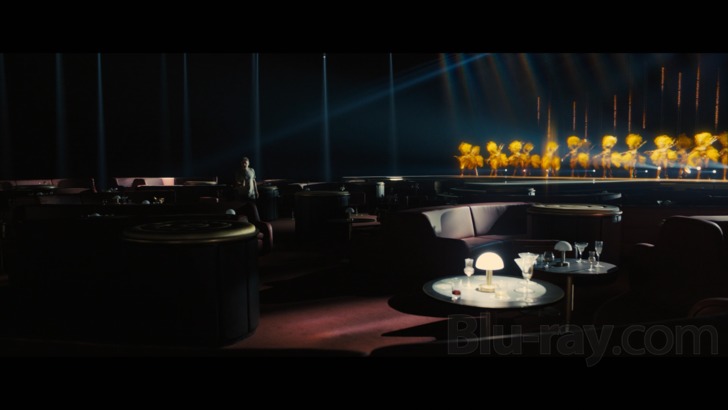Blade Runner 2049 Blu-ray Movie
HomeBlade Runner 2049 Blu-ray Movie 
Blu-ray + DVD + Digital CopyWarner Bros. | 2017 | 164 min | Rated R | Jan 16, 2018
Movie rating
8.5 | / 10 |
Blu-ray rating
| Users | 4.7 | |
| Reviewer | 4.5 | |
| Overall | 4.5 |
Overview
Blade Runner 2049 (2017)
Thirty years after the events of the first film, a new blade runner, LAPD Officer K, unearths a long-buried secret that has the potential to plunge what's left of society into chaos. K's discovery leads him on a quest to find Rick Deckard, a former LAPD blade runner who has been missing for 30 years.
Starring: Ryan Gosling, Harrison Ford, Ana de Armas, Sylvia Hoeks, Robin WrightDirector: Denis Villeneuve
| Sci-Fi | Uncertain |
| Epic | Uncertain |
| Thriller | Uncertain |
| Drama | Uncertain |
| Mystery | Uncertain |
| Film-Noir | Uncertain |
Specifications
Video
Video codec: MPEG-4 AVC
Video resolution: 1080p
Aspect ratio: 2.40:1
Original aspect ratio: 2.39:1
Audio
English: Dolby Atmos
English: Dolby TrueHD 7.1 (48kHz, 24-bit)
English: DTS-HD Master Audio 5.1 (48kHz, 24-bit)
French (Canada): Dolby Digital 5.1
Spanish: Dolby Digital 5.1 (640 kbps)
English: Dolby Digital 5.1 (640 kbps)
English DD=narrative descriptive
Subtitles
English SDH, French, Spanish
Discs
Blu-ray Disc
Two-disc set (1 BD, 1 DVD)
Digital copy
DVD copy
Packaging
Slipcover in original pressing
Playback
Region free
Review
Rating summary
| Movie | 4.5 | |
| Video | 4.5 | |
| Audio | 5.0 | |
| Extras | 3.0 | |
| Overall | 4.5 |
Blade Runner 2049 Blu-ray Movie Review
Legacy
Reviewed by Michael Reuben January 15, 2018Rarely has a movie arrived in theaters with the peculiar mixture of anticipation and dread that
awaited director Denis Villeneuve's sequel to Ridley Scott's 1982 Blade Runner. Although many
key members of the original creative team returned for Blade Runner 2049—including
screenwriter Hampton Fancher, visual futurist Syd Mead, original star Harrison Ford and Scott
himself as executive producer—the degree of difficulty seemed impossibly high. Scott's film was
a box office failure, but its influence has been incalculable, and its fan base has only grown larger
and more fanatical over time, spurred just as much by the originality of Blade
Runner's dystopian imagination as by the new versions that continued to appear over the next
twenty-five years. Each of those versions, whether called "Workprint" or "Director's Cut",
supposedly brought us closer to the original vision that Scott was forced to compromise due to
financial constraints and a production beset by strife. Blade Runner has long been steeped in dual
mythologies, one from its provocative content and another from its tortuous path to the screen.
After many hurdles both legal and technical had been cleared, the version officially
designated as "the Final Cut" finally appeared in 2007, but it didn't so much lay any controversies to
rest as open a whole new chapter.
How could any sequel hope to satisfy such a phenomenon's legions of devotees? How could any
creative team not be crushed by the sheer magnitude of an attempt to build on a vision rivaling
Kubrick's 2001: A Space Odyssey for its
originality and its impact on virtually every futuristic
vision that has followed? (Even Luc Besson's comically colorful The Fifth Element walks in
Blade Runner's shadow, because Besson was deliberately trying to do the opposite of whatever
Scott had done.) And how could the story be continued in a way that maintained the delicately
poised ambiguities of Scott's narrative, with its cosmic reverberations and stubborn existential
riddles? Blade Runner may have taken the form of a police procedural wrapped in an eye-poppingly art-designed future, but it was
ultimately a sustained meditation on what it means to be
human.
That Villeneuve and his team succeeded as well as they did is almost as much of a miracle as
Scott's achievement in the original film. It may be an unfortunate badge of their success that the
initial box office for BR 2049 was widely considered disappointing, though nowhere near the
fizzle endured by the original in 1982. Entertainment
Weekly recently pronounced BR 2049 one
of 2017's noteworthy failures, but I think such judgments are premature. The film is destined for
a long afterlife, and while it cannot hope to attain the original's influence—that intensity of
lightning doesn't strike twice—the sequel has now become an essential part of the Blade Runner
lore. Its continuation of the original film's tragic tale and its relentless questioning of the nature
of humanity arises so naturally and organically from Scott's work that the two films cannot be
separated. If you love the first Blade Runner, you are destined to love BR 2049—maybe not right
away, but eventually.

I saw BR 2049 on its opening weekend after carefully avoiding all advance publicity beyond the teaser trailer, and I was thrilled by the film's surprises, many of which have been engineered to play upon the expectations of those who know the original Blade Runner as intimately as BR 2049's creators obviously do. Since then, I have seen numerous reviews and discussions that reveal secrets of the sequel both big and small. I don't want to add to their number, because I assume that many purchasers of the Blu-ray and UHD will be first-time viewers. So let's stick to the bare essentials.
BR 2049 is set thirty years after the elevator door slammed shut on Rick Deckard (Harrison Ford) and his replicant lover, Rachael (Sean Young), as they fled a dark and sodden Los Angeles just a few steps ahead of fellow cop Gaff (Edward James Olmos), who was supposed to complete the "retirement" (i.e., execution) of Rachael that Deckard refused to carry out. (Or maybe Gaff let them go; Scott's film leaves the question open.)
Much has changed since then, and not for the better. Under the guidance of visionary industrialist Niander Wallace (Jared Leto), who acquired the Tyrell Corp. after the death of its founder (and a few other unfortunate incidents), replicants have successfully been used to further the colonization of space. Indeed, much of the human race has relocated to the off-world colonies that were being so heavily promoted in the original film. Large portions of Blade Runner's crowded L.A. are now uninhabited. They're also dark, thanks to an EMP disaster known as "the Blackout" that, in 2022, wiped out much of the world's financial and other data.
Replicant technology has progressed from the Nexus 6 stage of which Rachael was the most advanced to the current Nexus 8. Unlike their predecessors, Nexus 8's have a normal human life span, and the memory implants pioneered by the Tyrell Corporation have made them more easily controllable and thus more reliable. But soon enough, even supposedly reliable Nexus 8's begin thinking for themselves and revolting, which is why the authorities continue to need blade runners, officers specially qualified to hunt down and "retire" errant replicants, which was Deckard's job in the original film. BR 2049 centers on a blade runner who goes by the name of "K" (Ryan Gosling), and it's surely no coincidence that this was Franz Kafka's preferred designation for his protagonists trapped in bureaucratic nightmares. A lone and melancholy figure, K reports to a tough commander, Lt. Joshi (Robin Wright), who views their work as a holy calling, an essential bulwark protecting humanity from its own creations. (After the events of the first film, you can see her point.)
As BR 2049 opens, K has tracked a replicant named Sapper Morton (Dave Bautista) to a remote location where he is hiding in plain sight as a farmer raising the grubs that have become the planet's principal source of food. But the mission produces some unexpected evidence, sending K on a new investigation that will eventually lead him to Deckard, who is hiding in the remains of a former metropolis that was thought to have been rendered uninhabitable by radiation, possibly from the Blackout. K's latest investigation is one in which multiple parties take a keen interest. Chief among them is Niander Wallace, who believes that K has stumbled onto something that will propel Wallace Corp. to new heights of technological achievement. Wallace, who is blind, operates through a replicant assistant that he has ironically named Luv (Sylvia Hoeks). Luv may be as immaculately manicured and coiffed as Rachael in the first film, but she is just as dangerous as the replicant assassin Zhora (Joanna Cassidy), memorably and bloodily retired by Deckard.
K does not have a Rachael to fall in love with. Whatever heart he may have belongs to an A.I. known as Joi (Ana de Armas), who is like a holographic Alexa and such a common product that K sees her image wherever he goes. But Joi adapts to each owner so thoroughly that she and K have developed a love affair that could almost be described as passionate, except that you can see on K's face his lingering awareness that Joi is just a simulation. No matter how hard he may pretend otherwise, he can never forget that she's incapable of genuine love. (Or is she? The film's events certainly suggest otherwise.) Even their physical connection is a charade, achieved through the involvement of a self-described "real girl", a hooker named Mariette (Mackenzie Davis), who looks like the second coming of Darryl Hannah's Pris in the first film and who has her own agenda, like everyone else in BR 2049. Well, almost everyone else. K's investigation introduces him to Dr. Ana Stelline (Carla Juri), a designer of memories for replicant implementation, who lives alone in a sealed environment required to protect her compromised immune system. Dr. Ana seems to care only for her work, which is her sole source of companionship, much like J.F. Sebastian's toys in the original film.
At the core of BR 2049 lies an unexpected but entirely logical response to the demand made by Rutger Hauer's Roy Batty in the first film for "more life!" In his own twisted way, Niander Wallace is attempting to fulfill that request, though not by any means that would have satisfied Batty. Wallace's goal is not to prolong one replicant's life but to multiply their numbers, supplying the world with infinite legions of Battys (and Pris's and Zhoras and Luvs and Sapper Mortons), numbers so vast that they exceed the endless fields of human pods in The Matrix— except that these beings will be controlled by humans instead of machines: a small and select group of humans who can share Wallace's vision. The world that Wallace envisions is bleak but beautiful, like the vast cathedral-style spaces of his domain at Wallace Corp. Some lives, and many freedoms, may have to be sacrificed to attain this technological utopia under Wallace's (mostly) benevolent control. But such is the price of progress.
Blade Runner 2049 Blu-ray Movie, Video Quality 

Blade Runner 2049 was shot digitally on the Arri Alexa by the legendary Roger Deakins, one of
the pioneers of digital cinema. Deakins oversaw the film's formatting in two different aspect
ratios, 2.39:1 for standard venues and a "taller" version for IMAX theaters framed at 1.90:1.
Warner's 1080p, AVC-encoded Blu-ray contains the standard width (at 2.40:1), which I think is
a missed opportunity, because the IMAX version, which I saw theatrically, makes more effective
use of Dennis Gassner's imposing production design, with its towering ruins and vast interior
spaces. For that reason alone, I cannot give the Blu-ray's video a perfect score.
Nevertheless, the Blu-ray's image is an effective reproduction of BR 2049's varying
environments, which range from the bleak wastelands outside the city limits to the wide and open
spaces in the skies above L.A. (noticeably emptier than in Ridley Scott's film due to off-world
migration) to the pockets of crowded street life that evoke the original film's claustrophobic
urban masses. A vast junkyard is the site of twisted wreckage and barely functional structures
where K visits an orphanage that's more like an internment camp, and the detail of the twisted
steel and urban detritus is impressively displayed. Black levels and fine detail are excellent
throughout.
BR 2049 opens with company logos that have been desaturated, and much of the film is
deliberately monochromatic, especially when K is alone in his apartment or venturing into some
distant locale. Indeed, most of the film's human characters seem to inhabit environments drained
of color, like the vast yellow-and-golden expanses of Wallace Corp. The brightest colors are
generally found in computer imagery and simulations like Joi and in the vibrant neon signage,
ads and holographic projections that still light up parts of the city. (Mariette and her fellow
streetwalkers seem to have taken their cue from the advertising; their attire is the only colorful
clothing in the film.) Some of the most brilliant displays of color appear during a holographic
lounge act that appears late in BR 2049 under circumstances best left for the reader to discover.
The Blu-ray reproduces all of these palette shifts with aplomb, accurately and vividly re-creating
the theatrical experience.
With a running time of two and three-quarter hours, BR 2049 needs all the digital real estate it
can get, and Warner has used an entire BD-50, but, especially with the inclusion of HD extras,
the average bitrate is on the low side at 20.34 Mbps. Nevertheless, the bit budget appears to have
been carefully managed, and the encode has been capably performed.
Blade Runner 2049 Blu-ray Movie, Audio Quality 

Blade Runner 2049 arrives with a Dolby Atmos soundtrack that is as adept at sound and fury as
at subtle background ambiance. The report of Officer K's powerful weapon is thunderous and
powerful, and so are the deep bass percussion beats of the score by Hans Zimmer and Benjamin
Wallfisch that creatively builds on Vangelis' signature cues for the 1982 original. (And in a few
critical instances, Zimmer and Wallfisch step entirely out of the way and let Vangelis take over.)
Atmos' height capabilities make the initial entrance of K's spinner feel like it's nearly taken off
your head. The drone strikes on a mob in the wilderness genuinely sound like they're coming
from above.
Quieter sounds are effectively dispersed throughout the listening space: buzzing of bees in the
apiary that K is surprised to find during his quest; the distant piano notes that play like memories
when K enters the building where Deckard is hiding; the cacophony of voices, advertisements
and street noise when K is accosted on a promenade by Mariette and her co-workers; the
torrential rain that is an essential component of the Blade Runner world; the rushing waters
outside the L.A. seawall in a climactic showdown between . . . somebody and somebody. Like
the Dolby Atmos remix done for Blade Runner: The
Final Cut, BR 2049's soundtrack takes
creative advantage of Atmos' spatial capabilities and makes full use of its dynamic range. It
knows when to shout and when to whisper. It's a beautiful track.
Note that the Blu-ray also offers an alternative DTS-HD MA 5.1 track. I'm not sure why it's
necessary, since Atmos offers a lossless Dolby TrueHD core, but it's there for anyone who wants
it.
Blade Runner 2049 Blu-ray Movie, Special Features and Extras 

- Designing the World of Blade Runner 2049 (1080p; 1.78:1; 21:55): A comprehensive overview of the newly imagined world of the film, with substantial contributions from the cast and creative team.
- To Be Human: Casting Blade Runner 2049 (1080p; 1.78:1; 17:15): Director Villeneuve and the film's producers discuss their casting efforts for all of the major and most of the minor roles in the film.
- Prologues (1080p; 1.78:1): These three prequels were initially issued online prior to the film's theatrical release. Each is introduced by Villeneuve. A "play all" function is included.
- 2022: Black Out (15:45): In a stylish anime directed by Shinichiro Watanabe, we learn the story of "the Blackout" that is repeatedly referenced throughout the main film.
- 2036: Nexus Dawn (6:31): Directed by Luke Scott (son of Ridley), this live-action short recounts how genius industrialist Niander Wallace, after acquiring the Tyrell Corporation, was able to lift the prohibition on manufacturing replicants.
- 2048: Nowhere to Run (5:49): Also directed by Luke Scott, this second live-action short is set one year before the film opens and reveals how Sapper Morton fled Los Angeles for the remote farm to which K eventually tracks him.
- Blade Runner 101 (1080p; 1.78:1; 11:22): A series of short featurettes on various aspects of the Blade Runner universe and the film's design. A "play all" function is included.
- Blade Runners
- The Replicant Revolution
- The Rise of Wallace Corp.
- Welcome to 2049
- Jois
- Within the Skies: Spinners, Pilotfish and Barracudas
- Introduction: At startup, the disc plays a trailer for the Blade Runner: Revelations gaming experience.
Blade Runner 2049 Blu-ray Movie, Overall Score and Recommendation 

Newcomers should be warned that BR 2049 replicates the original's deliberate, contemplative
pace, alternating lengthy passages of quietly thoughtful characters and intriguing vistas with sudden
bursts of intense, violent action. It's not a film for short attention spans. Like its predecessor, it
demands sustained attention—and amply rewards it. Leaving aside the unfortunate decision not
to use the IMAX-formatted ratio, the film's Blu-ray presentation is a superb rendition, within the
limitations of the format. But if you want to see BR 2049 at its best, consider the excellent UHD.
Both are highly recommended.
Other editions
Blade Runner 2049: Other Editions

Blade Runner 2049 4K
IMAX Enhanced
2017

Blade Runner 2049 4K
2017

Blade Runner 2049 4K
2017

Blade Runner 2049 3D
2017

Blade Runner 2049 3D
2017

Blade Runner 2049
Limited-Edition Steel Model Spinner
2017

Blade Runner 2049
2017

Blade Runner 2049
2017
Similar titles
Similar titles you might also like

Blade Runner 4K
The Final Cut
1982

Westworld: The Complete Series
2016-2022

Arrival 4K
2016

Ex Machina 4K
2015

Fringe: The Complete Series
2008-2013

Dollhouse: Season 2
2010

The Day the Earth Stood Still
2008

V: The Complete Second Season
2011

400 Days
2015

Self/Less
2015

Extant: The First Season
2014

The Prestige 4K
2006

The Day the Earth Stood Still
Special Edition
1951

THX 1138
The George Lucas Director's Cut
1971

Contact
1997

Elysium 4K
2013

Atlas Shrugged: Part I
2011

12 Monkeys: The Complete Series
2015-2018

Replicas
2018

Automata
Autómata
2014
